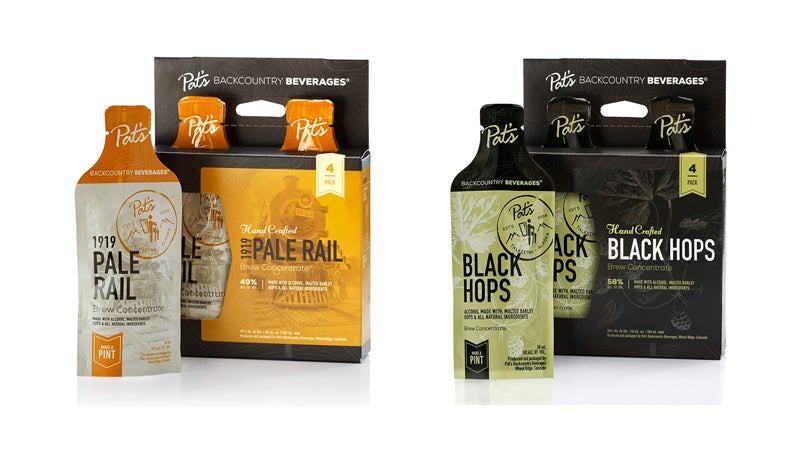We’ve written about��Pat's Backcountry Beverages Carbonator, the Nalgene-size system for fizzifying your drink of choice where ever the trail takes you. And while we've talked about Pat's alcohol-packed beer flavors—the world's first beer concentrate, according to the company—we haven't put them to the test. Until now.
As a backpacker and a booze writer, when I heard about (complete with alcohol!) I couldn't resist checking them out. After all, who among us hasn't fantasized about some sweet suds at the end of a long, hot hike? But could these “beers” pass the taste test of an admittedly picky beer drinker? The short answer—Yes.
For those unfamiliar with the idea, Pat's Backcountry Beverages Carbonator is a plastic bottle with built-in levers, valves, and cups. You add a mixture of potassium bicarbonate and citric acid to the small charging cup within the bottle, pull a lever on the cap a few times to add water, and a chemical reaction starts, releasing CO2 into your beverage of choice. In this case, your beverage of choice would be beer.
Pat's offers two flavors: Pale Rail and Black Hops. They both come in portable, 1.7-ounce liquid packets that you add to the water before you charge it. These packets are sold in four-packs for $10 a pop, which isn't too outrageous compared to your standard micro-brew.
It's worth noting that these aren't merely “beer flavored.” Founder Pat Tatera��developed what he calls a “Hybrid Brewing Process.” The beer begins as a normal beer would, except once it's done fermenting, he vacuum-distills it. This pulls out most of the water and the alcohol, which Tatera sets aside, leaving a beer-like syrup. Then he restarts the brewing process, but instead of using water to create the wort, he uses the beer syrup. He repeats these steps four times, then soaks Cascade Hops in the reserved alcohol to extract their flavor, and combines that with the syrup. The result? A little packet of concentrated beer. Just add fizzy water.
I went through the process exactly as I would if I were in the field, using cold, bottled water to simulate filtered water from a stream. Despite Pat's claim that it's just three steps, there are several steps within each step, and you'd be hard-pressed to remember them all if you didn't bring the instructions. It takes approximately five minutes to brew each beer. Here's how they measure up to the real thing.
Pale Rail
The certainly has the look and color of a pale ale, but when you smell it, something seems just slightly off. It's unmistakably malty, and it has that fermented, beer aroma, but it's just a little, well, funky. It smells too sweet, as if it had spoiled a little. Tasting it was a pleasant surprise though. It's a little sweeter than I'd like, but the pale ale hoppiness is there, mostly in the after-taste. It doesn't have that sharp, citrusy flavor you typically associate with Cascade Hops, but at the end of a long hike, it would definitely scratch the itch. At 5.2% ABV, it'll put a little grin on your face.
Black Hops
The smell is a little cleaner on this one. You don't get much in the way of hops on the nose, but you get those. It's dark and molasses-like, but not as syrupy as the Pale Rail. As soon as you take a sip, you’re hit by clean, sharp flavors. Nice and dry, although it does have a bit of a bitter after-taste. It is missing that fresh hop flavor—that grapefruity, piney, almost weedy����DZ�—but overall, it's really good. If someone poured it for me at a bar, I wouldn't think twice about drinking it, and I be absolutely psyched to have it at the end of a trail. I would actually��look forward��to this at the end of a hike, not because of the alcohol content (6.1% ABV), and not because it reminds me of a beer, but because it actually tastes like a good, real beer.
��
So what’s the bottom line? While it's a struggle to get the drink as carbonated as you'd want (the best I ever got was analogous to a draft beer that had been sitting out for a good half-hour), the flavors are on-point. The Pale Rail is still a tad too sweet, but the Black Hops is most definitely worth the price of admission. I'm absolutely bringing it on my next trip, and if you're a beer lover, I suggest you do the same.��
$10,��


